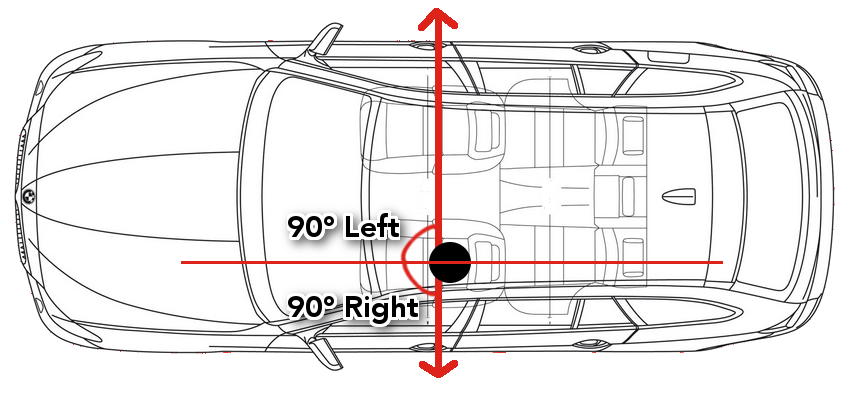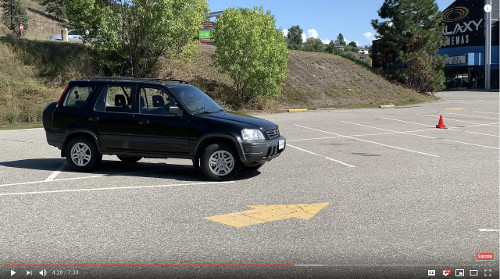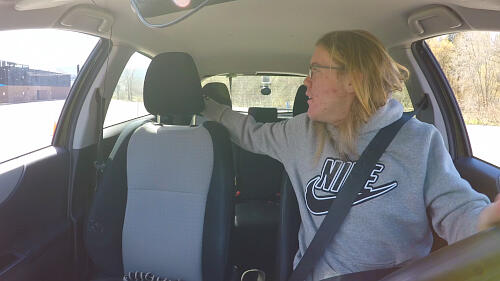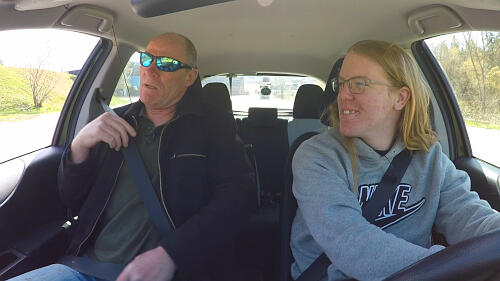Be a smarter driving instructor with these 11 tips!
Table of Contents
CLICK FOR TO SECTION
 Your job as a driving instructor is to take the student out of her comfort zone. But also to be a safety net and intervene if something goes wrong.
Your job as a driving instructor is to take the student out of her comfort zone. But also to be a safety net and intervene if something goes wrong.
What is Your Job as a Driving Instructor?
- So you're embarking on a new career as a driving instructor?
Today, we have 11 tips to help you be more effective and to be a smarter driving instructor to help your students.
Stick around, we'll be right back with that information.
Two points before we get started here.
What's your job as a driving instructor?
Your job as a driving instructor is to take the student out of his or her comfort zone because that's where the real learning begins.
And in the event that something goes wrong, you also act as a safety net.
And as the driving instructor, always be learning something, whether that's learning a musical instrument or playing a sport or another language, because learning something will make you a more empathetic teacher.
 Never, ever let a student that just took his driving test drive home from the DMV....ever!
Never, ever let a student that just took his driving test drive home from the DMV....ever!
Don’t Let the Student Drive Home from Test
Tip number one, never let the student drive home from the test.
A few years ago, I had a student was going with the fire department, drove the firetruck, took the test, passed the test.
We went back to the fire station.
Student drove around the back of the fire station, pulled up in front of the door and then proceeded to back into the door at the fire station.
 Never criticize and student. Give correction and feedback on the skills and abilities they need to pass a driving test.But I thought, well, it's the firetruck, I probably shouldn't be driving it.
Never criticize and student. Give correction and feedback on the skills and abilities they need to pass a driving test.But I thought, well, it's the firetruck, I probably shouldn't be driving it.
But this gets better.
Student pulled forward, went, oh, pushed the garage door opener and then proceeded to back into the fire station with the firetruck.
Never let a student drive home from the driving test ever, ever.
Have Good Relationships With Driving Examiners
Tip number two, foster professional relationships with the driving examiners.
Students will come and go, but you will be there all the time as will the driving examiners at your local test center.
 Never believe that a student can drive. Always start them off in a closed-circuit area.Have a good relationship with them.
Never believe that a student can drive. Always start them off in a closed-circuit area.Have a good relationship with them.
Talk to them after they come back with the student and they've done the testing, whether it's a pass or whether it's a fail, get the information.
And I will tell you, 9 times out of 10, you're going to need to believe the driving examiner, not what the student says.
Be empathetic with the student, but believe what the driving examiner says.
Do a Pre-Trip Before Any Test
Tip number three, always do a pre-trip inspection on your vehicle before going down to the test center to do a test with a student.
 At the end of the driving lesson give feedback on the drive and 1 or 2 skills to practice and work on in the time before your next lesson.
At the end of the driving lesson give feedback on the drive and 1 or 2 skills to practice and work on in the time before your next lesson.
There's nothing more embarrassing than having a brake light out and the student is denied his or her test.
As well, keep cleaning supplies in the vehicle.
When you've got a bit of downtime, make sure that the vehicle is clean, the inside is clean.
Take it, get it washed.
That way, you're going to maintain a professional image and everything is going to work better for you.
The Distraction Lesson & Student Focus
Tip number four, the distraction lesson.
 In the short time you have available as a driving instructor, expose the student to as many different driving environments as you can.Engage in conversation with the student, not at the beginning lessons, the first couple lessons, because you're going to be doing something else.
In the short time you have available as a driving instructor, expose the student to as many different driving environments as you can.Engage in conversation with the student, not at the beginning lessons, the first couple lessons, because you're going to be doing something else.
But after the second or third lesson, talk to the student, try to distract them.
And then eventually you can get to a point where you're actually having a lesson where you're completely trying to distract the student.
The student must have the ability to focus when they're executing complex maneuvers, such as left-hand turns, parallel parking, or those types of things.
So engage in conversation.
As well, you want to move from the beginning where you're telling the student what to do and giving them step-by-step instructions to the point where you're simply asking the student what he or she is doing and why he or she is doing what they're doing.
Because students telling you what they're doing while they're doing it are at a much higher rate of taking on and retaining that information, skills, and abilities.
 New drivers are NOT going to be able to distinguish between 2- and 4-WAY STOP signed intersections. You'll spend some time on these different intersections.So get the student to be doing a running commentary while he or she is driving.
New drivers are NOT going to be able to distinguish between 2- and 4-WAY STOP signed intersections. You'll spend some time on these different intersections.So get the student to be doing a running commentary while he or she is driving.
And that way they're going to learn faster and retain a much higher percentage of their information.
This video is made possible by the course package Pass Your Driver's Test First Time, because we know that your driver's test is the most stressful day of your life.
And without some form of driver training, your chances of passing are less than 50%.
As a bonus, we'll include both the defensive and winter driving smart courses.
These will make you a safer, smarter driver and reduce your chances of being involved in an accident.
Click down in the description there and get full details.
Taking Control of the Vehicle is a LAST Resort
Tip number five, don't take control of the vehicle with the instructor's controls unless it is an absolute emergency.
 There are instructor controls in your vehicle, but only use these as an absolute last resort. Taking control of the vehicle undermines the student's confidence and your authority.If you take control, it simply erodes and undermines the student's confidence and also it chips away at your authority as well.
There are instructor controls in your vehicle, but only use these as an absolute last resort. Taking control of the vehicle undermines the student's confidence and your authority.If you take control, it simply erodes and undermines the student's confidence and also it chips away at your authority as well.
You failed to communicate effectively what you needed the student to do.
Or you weren't teaching him or her the proper defensive techniques to be able to deal with an emergency situation or a situation on the roadway.
So last resort - using the instructor controls.
Know that in all the years that I've been teaching driving I can count on one hand the number of times I've used the instructor's controls.
There are a number of ways you can take control of the vehicle from the passenger's seat.
 One of the toughest parts of a driving instructor's job is to push the student just enough. Too much and he'll freak out...not enough, and he's not learning.You can manipulate the steering wheel, you can put the transmission into neutral, or you can apply the brake on your side.
One of the toughest parts of a driving instructor's job is to push the student just enough. Too much and he'll freak out...not enough, and he's not learning.You can manipulate the steering wheel, you can put the transmission into neutral, or you can apply the brake on your side.
And maybe you have a full set of controls on your side.
I've heard driving instructors had different opinions about that, but in my professional opinion, it's a last resort to be using the instructor's controls on the vehicle.
Be Able to Demonstrate All the Manoeuvres Required for Test
Tip number six, be able to demonstrate all of the skills and abilities and techniques that the student needs for the purposes of his or her driving test and learning how to drive.
Most of those are going to be turning and parking.
Left turns, right turns, parallel parking, three-point turn and reverse stall parking are going to be your major skills and abilities that you're going to have to demonstrate to a student.
 Not all your students learning to drive and preparing for a road test are going to be young people. And I'll put a list of all of those videos down in the description there that will help you out.
Not all your students learning to drive and preparing for a road test are going to be young people. And I'll put a list of all of those videos down in the description there that will help you out.
You can have a look at those and we'll give you step-by-step instructions on how to do that, because you can only explain stuff so many times and the student may or may not get it.
5 minutes, 10 minutes behind the wheel, demonstrating the technique or skill that the student needs is oftentimes going to be enough that they're going to go, "Oh, aha."
So what I suggest, let them do it a couple of times, parallel parking, for example, and if the student's just not understanding the technique then demonstrate.
Get behind the wheel, demonstrate, show them how to do it and then let them do it again and you'll find that approach to teaching works really well for the student and they're able to take on that information and retain that information at a much higher level.  As a driving instructor, you must be able to demonstrate all the skills required for the driver's test and give commentary.
As a driving instructor, you must be able to demonstrate all the skills required for the driver's test and give commentary.
You’re Not Going to Save the Driver’s Life
Tip number seven: you're not going to save the student's life.
In the skills and abilities and techniques that you teach them, you're not teaching them how to drive, you're not going to save their life.
Something you may say or something you may do when you're demonstrating techniques and skills might save their life one night coming home, but you just don't have the time.
And most of the time, you're simply teaching these students how to prepare and pass the driver's test.
Unfortunately, there's just not enough time.
And many of the things that happen in driving, for example, driving at night in the rain, you're just not going to have time to be able to do that.
And that's probably not ever going to happen in the driving lessons that you provide to the student, unless driving at night in the winter time, it gets dark early and you have snow and ice on the roads.
 Teaching new drivers to shoulder check every time they change the vehicle's direction is one of the most critical skills you will teach as a driving instructor.
Teaching new drivers to shoulder check every time they change the vehicle's direction is one of the most critical skills you will teach as a driving instructor.
But many of the situations that they're going to encounter, you're simply not going to encounter in your driving lessons.
So do the best you can in the short time you have with the student.
Where to Get the Correct Information
Tip number eight: where to get information about rules, regulations, and procedures?
You're going to get conflicting information from students, from other driving instructors, and whatnot.
So where do you get the correct information?
Conflicting information, how to manipulate the steering wheel, hand to hand or hand over hand, for example.
Go to the driving examiners. That's your first place for information because they're the gatekeepers.
They're the ones looking for the skills and abilities for the student to pass his or her driver's test.
 As a driving instructor, you simply don't have time to teach a new driver everything they need to know about driving. For example, it may never rain during your lessons, but you still need to show the student how to turn on the wipers, defost and headlights.Ask the driving examiners.
As a driving instructor, you simply don't have time to teach a new driver everything they need to know about driving. For example, it may never rain during your lessons, but you still need to show the student how to turn on the wipers, defost and headlights.Ask the driving examiners.
And this is why you foster a professional relationship with them so you can ask them questions and be teaching the students the correct way to do something to pass his or her driving test.
Ask other driving instructors who you work with.
They'll give you the correct information.
Go to the driving handbook.
If it's not in the driving handbook, then go to the Highway Traffic Act.
And just on the note of the driving handbook, there can be conflicting information in the driving handbook.
 Emergency vehicles, yellow lights, and turning right on a red light are just some of the unexpected events that only happen every now and again.For example, in the province of Nova Scotia, you can see here that it says you must do 30 all the time when school is in session and obey the school speed zone signs.
Emergency vehicles, yellow lights, and turning right on a red light are just some of the unexpected events that only happen every now and again.For example, in the province of Nova Scotia, you can see here that it says you must do 30 all the time when school is in session and obey the school speed zone signs.
But if you go down further here, it says that you need to do 50 kilometer.
You can't do more than 50 kilometers an hour in a school speed zone because there might be children playing at the school.
So therefore, the school speed zone only applies when school is in session.
But if you just look at this first bit of information, you would think differently.
So know that handbooks aren't always written so that they're clear and you might have to do a bit of interpretation with that.
So again, ask the driving examiner, ask other instructors, go to the Highway Traffic Act.
 Although not sexy, working in a parking lot with pylons will improve a student's driving faster because you're working on the fundamentals.
Although not sexy, working in a parking lot with pylons will improve a student's driving faster because you're working on the fundamentals.
You’re the Captain of the Ship
Tip number nine: you're the captain of the ship.
Don't let the student tell you that this is the way that he or she is supposed to do it for the purposes of the driver's test.
Be firm, be professional.
Tell him or her that this is the way that I teach it.
This is the way that it's done for the purposes of passing their driving test.
You're going to get conflicting information.
You show me 50 driving instructors, I'll show you 50 different ways to teach a student to drive a car and to pass a driver's test.
So develop your own skill, and don't take any guff from students that, oh, this driving instructor told me to do this or do that.
 Teaching a student to reverse in a straight line for a distance is a powerful learning tool.No.
Teaching a student to reverse in a straight line for a distance is a powerful learning tool.No.
And unfortunately it's going to happen because you might work in a school with driving instructors where students are moved between different driving instructors.
That's just a reality of the business.
You've got to be firm, you've got to be professional.
Never Believe a Student Can Drive
Tip number 10, never believe a student, always do an assessment for learning.
Always start a student out in a controlled area where he or she can demonstrate that they know how to work the throttle, they know how to work the steering wheel, and they know how to work the brake before you take them out into traffic.
I had a student some years ago, I'd been working with them all weekend on a theory course.
 Self-confidence is one of the most important skills you as a driving instructor will teach new drivers.And then we went out in the vehicle and I thought the student had a lot more ability than they actually did.
Self-confidence is one of the most important skills you as a driving instructor will teach new drivers.And then we went out in the vehicle and I thought the student had a lot more ability than they actually did.
Student ran into a concrete barrier.
So never ever listen to a student.
At the beginning in the first lesson, let them show you that they actually know how to drive the vehicle.
As well, it's an assessment for learning.
How Much Information Can the Student Take on & Process?
You're not only figuring out what their skills and abilities are, but how well they can take on information.
 Over the course of your teaching and lessons, move from telling students what they did wrong in a driving maneuver to asking them what they did wrong.So if you explain to them how to do a right turn and they do it perfectly, you can say, okay, well, maybe we can move on to left-hand turns and we can start doing those.
Over the course of your teaching and lessons, move from telling students what they did wrong in a driving maneuver to asking them what they did wrong.So if you explain to them how to do a right turn and they do it perfectly, you can say, okay, well, maybe we can move on to left-hand turns and we can start doing those.
You're modifying your lessons to the individual student based on his or her abilities and skills.
And you're either going to go down in what you're teaching them to slow speed maneuvers and working in a parking lot or you're going to go up and working in high-density traffic and working at complex intersections.
Never, Ever Yell At a Student
Tip number 11, the most important.
And this goes without saying: don't ever, ever yell at a student.
Yes, there are going to be students that are going to test you, that are going to be frustrating and things are going to happen, but don't ever yell at a student.
It completely undermines his or her confidence and it completely erodes your authority as a driving instructor.
 If your students are having challenges keeping track of the steering wheel, put a piece of tape at the top.Don't yell.
If your students are having challenges keeping track of the steering wheel, put a piece of tape at the top.Don't yell.
And actually when you're in the vehicle, go flat.
Okay?
It's an intimate setting.
You're sitting very close to the student.
So I just call it going flat.
Years ago, when I was working as a driver rehabilitation specialist, I worked with an occupational therapist and we were doing an assessment with a student who had had a brain injury.
Halfway through the assessment, he was doing really well.
I looked at Deb in the back and we kind of nodded to each other and we're like, yes, he can be trained.
 Only give instruction when the student is driving in a straight line. As a driving instructor, stop talking when the student is executing a complex maneuver.And so I started doing some teaching.
Only give instruction when the student is driving in a straight line. As a driving instructor, stop talking when the student is executing a complex maneuver.And so I started doing some teaching.
We were merging onto the highway and I told the student, I said, "Listen, you need to stay right on the end, get up to 100 kilometers an hour and then merge over, pick your spot and move over."
The student gets on the acceleration lane, gets to the end and kind of panics, and then drives off the end of the acceleration lane into the gravel.
Of course, the car's moving around and floating on the gravel at 100 kilometers an hour, 62 miles an hour, as it would.
I can hear Deb in the back go .
I just quietly said to the student on a very monotone language and said, "Just take your foot off the throttle."
And I just touched the steering wheel because I didn't want them to do any aggressive movement with the steering wheel.
 Be a professional driving instructor. If you're unsure or don't the answer to a question, tell the student that you'll get back to them.And so the student just took their foot off the throttle and everything was fine.
Be a professional driving instructor. If you're unsure or don't the answer to a question, tell the student that you'll get back to them.And so the student just took their foot off the throttle and everything was fine.
We slowed down, gained control of the vehicle and then merged out onto the roadway.
It's going to happen.
There's going to be in emergency situations where students do things you don't completely expect.
Students don't know what they don't know.
For example, two-way stop signs.
It's going to be something that you're going to find challenging.
Teaching students sufficient gap when they can go at left-hand turns or when they can proceed on a right-hand turn.
Those are challenging exercises, and the student doesn't know.
 The Ohio Maneuverability Test is one of the best tools in a driving instructor's tool box.
The Ohio Maneuverability Test is one of the best tools in a driving instructor's tool box.
I had a student a few months ago come up to a two-way stop sign intersection, stopped at the two-way stop sign intersection.
Didn't realize that they had to yield and find a gap on the cross traffic, and then just drove through the intersection.
It's an emergency situation.
It could be a little freaky because, of course, it's your side of the vehicle and that's where you're going to get T-boned, but you've got to maintain your cool, not yell at students.
And sometimes you just need to pull over, get out of the vehicle, take a little break, and then get back in and explain to the student what he or she did wrong.
Most important, tip number 11, never yell at a student.
 Always be able to tell students why they're doing a technique. Often if they know why, they'll continue to do it and be safer smarter drivers.
Always be able to tell students why they're doing a technique. Often if they know why, they'll continue to do it and be safer smarter drivers.
Hang on there one sec.
The thought of failing your driver's test is what keeps you up at night right now.
Click the link and check that out and have a great day.
All the best.
Bye now.

